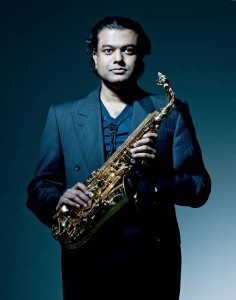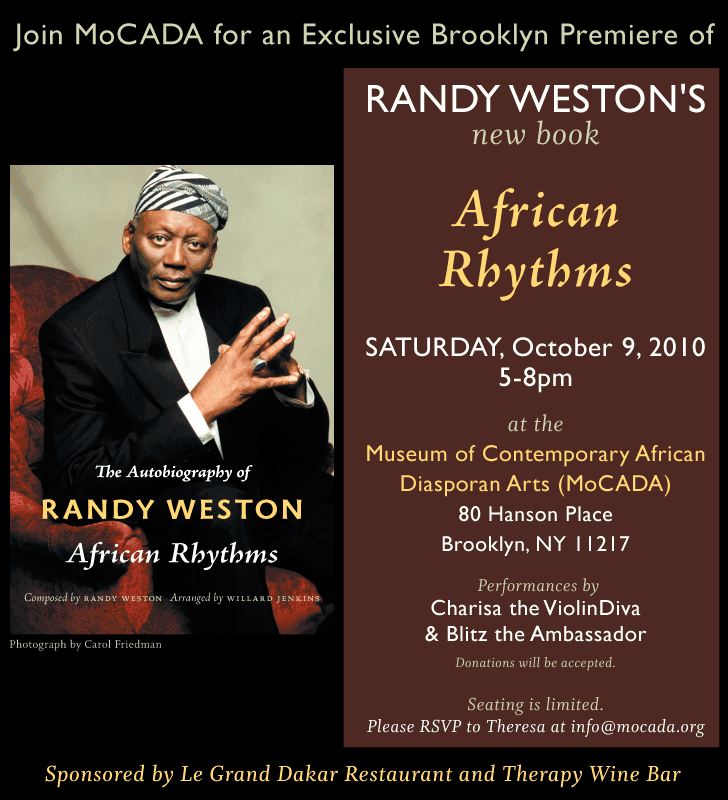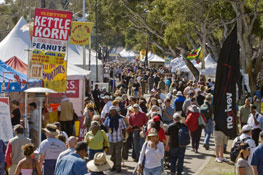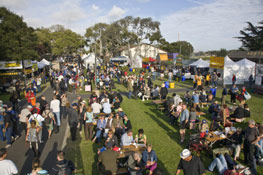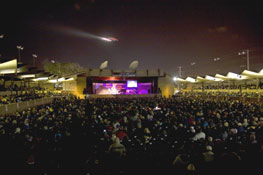Our series of conversations with African American jazz presenters and entrepreneurs last time took us to Brooklyn, NY, via our ongoing research project for the Weeksville Heritage Center (718/756-5250; www.weeksvillesociety.org for more information). In part two of our dialogue with the Brooklyn sage Jitu Weusi we examine the development of the East cultural center, a sadly defunct font of African American culture, education, jazz music, and pure black energy & spirit. In part the East grew out of the notorious Brooklyn empowerment struggle of the Oceanhill-Brownsville incident in which African Americans sought to take more control over schools and education curriculum content in the community, which resulted in a bitter teacher’s union strike. Major cornerstones of the East were the Uhuru Sasa school, a forerunner of the so-called charter schools movement of today, and a jazz concert series.
How did you and your cohorts arrive at the develoment of The East?

Jitu Weusi
By 1968 we had founded a group called the African American Student Association. The African American Student Association was comprised of young people 14-18. I was the adult advisor to this group, I was about 28-29. These young people were raising new stuff every day; raising new issues, new horizons, new visions, etc., every day. In 1968 we had the Oceanhill-Brownsville controversy and I was in the middle of that, and that tended to stigmatize me: ‘he’s a troublemaker, he’s a radical, he’s this, he’s that…’ So I knew that my time in public education was not going to be too much longer.
In 1969 I was banned from the campus of Pratt Institute. We were supposed to have a program there and the president banned me from the campus. The man didn’t even know me! He just issued an edict that if I set foot on the campus, the program would not be held. So the young people said ‘we want to establish our own cultural center.’ So that summer and fall we had gotten ahold of this building at 10 Claver Place. We cleaned out this building and began to restructure it as a cultural center. We had a couple of meetings and we came up with the name East. Basically that was a philosophical thing because we were dealing with Eastern values, as opposed to Western values. That’s where the name came from, it came from our attraction to Eastern values that we felt were values that dealt with internal values, spiritual values.
What was the mission of the East?
The mission was to bring enlightenment to our people — recreational, philosophical…
So how did you work to achieve that mission?
Through a number of different things; one was through the entertainment that we provided. Our opening performance was Leon Thomas, and from the very beginning our music was always radical. HGary Bartz, Freddie Hubbard, Rahsaan Roland Kirk… our music was always out there. Then one of the first things that we brought into the East was the bookstore. We pushed reading, understanding, books, studying, and upliftment. And then the next thing we brought in was a school: the Uhuru Sasa school became a vehicle for us educating young people and adults as well. The East thing was always an upliftment of a mind, forging of a higher objective, a higher goal, a better person, and self-improvement.
Did you pretty much have seven days of activities at the East?
Seven days — almost 24 hours, because we did everything, and we learned everything. We did everything on our own; we had a kitchen where we prepared food; we learned how to go to the market and deal with the market — vegetables, fruits, fish markets, meat markets… all those things. That was part of the enlightenment that people learned was how to deal with all that. People would come and tell us ‘man, I didn’t know nothin’ about all this stuff until I got involved with you guys… Now I’m running this and I’m running that…’
Hod did people in the community come to be involved with the East?
It was a membership kind of thing and [members] had to make a total commitment. If you worked at the East you didn’t make any money; we paid salaries like $100-200 a month, so you weren’t there because of money. You had to live on whatever you made, how to survive, how to advance. It was uncanny [but] people bought homes off $200 a month! We provided things like schooling for [employee’s] youngsters, but people had cars… People used to say ‘…damn, ya’ll don’t pay any money, but everybody around here looks like they’re well-off!’
Were you the director of the East from the start?
Yes, I quit the [New York Public] school system in November 1969 to devote full time to the East.
I’m aware of at least two recordings related to the East: Pharoah Sanders’ Live at The East (Impulse!), and the Mtume record Al-Ke-Bu-Lan (Strata East). Were there any other recordings made there?

Not that I can remember. We had music on [maximum] four nights a week: Thursday, Friday, Saturday, and Sunday. Some artists only wanted three nights, so we’d go Friday-Saturday-Sunday, or if they only wanted two nights we’d go Friday-Saturday. We had no official policy, but unofficially the only people who came to the East were black people. That’s not to say that an individual white person here or there did not come into the East, that would be erroneous.
Initially they didn’t pay us any mind, because [hypothetically-speaking], who was the East? But after awhile, when the word started getting out that there was this place, that the musicians really played there, and you could hear the music, they [audience] didn’t do no talking, wasn’t no bottles clinking, wasn’t no noise… people were into the music, this was a serious place… Then people started trying to come, people started coming… and we more or less had to inject that policy.
Was the school at the East — the Uhuru Sasa School — a regular k-12 school?
Yes, it was certified. One of our elected officials, a state senator, came to the school one day and he said ‘…man, you’d better get this certified, because if you don’t get this [school] certified they’re going to close you down. So he backed us up with the state Department of Education and he more or less guided us through a number of different situations with the state.
How did the East subsidize the school finanancially?
That was part of what the music did. The music helped us to pay for running the school. Take a typical Pharoah Sanders weekend: a Pharoah Sanders weekend meant a $5,000 weekend, which meant we could pay teachers’ salaries, we could buy food, we could do this, do that…
The musicians who played at the East were black musicians, and at least among the musicians you listed who played the East there’s a certain cultural consciousness. In terms of how the musicians were compensated, is the East a place where the musicians would give you a break, where they might not have given the same fee break to some other venues around New York?
Everybody that played [the East] got paid, nobody played for free. But they never charged us what they might have charged a Birdland, or the Vanguard…
The food policy at the East was obviously a major component.
Everybody talked about the food at the East; guys couldn’t wait until they had finished their set to send [their food orders] down to the kitchen. We had chicken dinners, fish dinners, and vegetarian dinners. We had this vegetarian rice called Kawaida Rice, big green salads, potato salad, collard greens… We used to produce sometimes 300-400 plates of food per night! That’s a lot of food coming out of one little kitchen a night. Food became a major way that we earned money through the East to pay for our expenses.
What was the lifespan of the East?
The major duration was from about 1970-1977. After ’77 was stage two, which went from ’78-’86; in ’86 we closed down.
What was different about stage two of the East?
Stage two was less music; not every weekend, just music every once in awhile. We moved from 10 Claver Place to an Armory on Sumner; we had a larger venue, but the venue wasn’t as cozy, the sound wasn’t as good, it had a high ceiling which sucked away all the sound. The venue wasn’t as good so we ended up having music once a month.
The East spurred the development of one of this country’s major black arts street festivals.
It started off as the African Street Festival, later on it became the International African Arts Festival. In 1970-1971 we noticed a pattern – we would run out of money at mid-end of June, and we’d have debt. My thing was always pay off debt, don’t accumulate any debt. So we wanted to figure out a way to make some money to pay our debt at the end of June, because June was the end of the school year and a lot of people would travel.
So the thing was to pay off our debt so we wouldn’t owe anything going into the summer. We discussed what to do and after awhile we came up with the idea of having this 3-day block party on Friday, Saturday and Sunday on Claver Place, which is a little compact block between Franklin and Clausen, and it’s also where Jefferson Avenue begins, so it’s sorta like a T [configuration]. The idea was to have this block party on this T and invite people to come down, move our whole entertainment thing outdoors, build a stage outside, sell food and have various merchants all up and down the block, sell merchandising space and so on.
The first year we did that, 1972, it started raining on Friday and it rained all night Friday, it rained all day Saturday, it rained all Saturday night. But when it stopped raining on Sunday morning at about 11:00 and the sun came up about 1:00, people jammed that little block. There must have been — no exaggeration — 10-15,000 people on that little block, from 1:00 Sunday until midnight, and it was fantastic… music, dancing… it was like something that you dreamed about; nobody had ever seen anything like that in that little space, and outdoors like that. And everybody made money. So even though two-thirds of it was rained out, the one-third that survived was enough to tell us that we had hit on something.
The next year, 1973, we cleaned up… No rain, we ran it for three days, the crowds were enormous… we cleaned up, everybody made money, we paid off our debts, the community was very happy, we were happy… The only ones unhappy was the Catholic church. The Catholic church had a yard there and they claimed people were peeing in the yard, different things. They had some balconies and they claimed photographers would go up there and shoot [photos] from the balconies.
So you had to make peace with the church; how’d that happen?
[African percussionist] Chief Bey — James Hawthorne-Bey — came over to the East one day and he said to me ‘I’m going to take you over to the church and we’re gonna make peace…’ [Laughs] I’m a warlike kind of person… ‘peace… get outta here…’ But I had a lotta respect for the Chief. He took me over to the church, we lit candles, prayed, the Father came down and we talked, and when we left there everything was cool, everything was alright. We reached a compromise that they would let us have the festival that year, at Claver Place, but the next year we would move the festival up to Boys & Girls High School, which had much more space to accommodate what we were doing.
It eventually became the International African Arts Festival. This is the 39th festival [2010] and the basic tenets are still in place, as far as arts, economics, culture. It’s very hard to find something that lasts 40 years that is still the same as it was the first year.
(Editor’s note: the new book African Rhythms, the autobiography of Randy Weston (composed by Randy Weston, arranged by Willard Jenkins; Duke University Press) contains a photograph of good friends Randy Weston and the master of afro-beat Fela Anikulapo Kuti when they played the African Street Festival. The festival also had a richly-deserved reputation for great black music.)
Next time: Jitu Weusi and several of his cohorts discuss the founding and development of the Central Brooklyn Jazz Coalition.
 RM: Everyone involved was hand selected not only for their tremendous musicianship but also because of our existing relationships. I met Jason soon after I moved to New York while sitting in with an early version of Greg Osby’s band in the late 90s. We haven’t worked together so much but we did perform together a few times. I’ve also sat in with his trio at the Vanguard, which was a real pleasure. Jason also played on Bunky’s last album Another Place, so they already had an existing relationship.
RM: Everyone involved was hand selected not only for their tremendous musicianship but also because of our existing relationships. I met Jason soon after I moved to New York while sitting in with an early version of Greg Osby’s band in the late 90s. We haven’t worked together so much but we did perform together a few times. I’ve also sat in with his trio at the Vanguard, which was a real pleasure. Jason also played on Bunky’s last album Another Place, so they already had an existing relationship.


